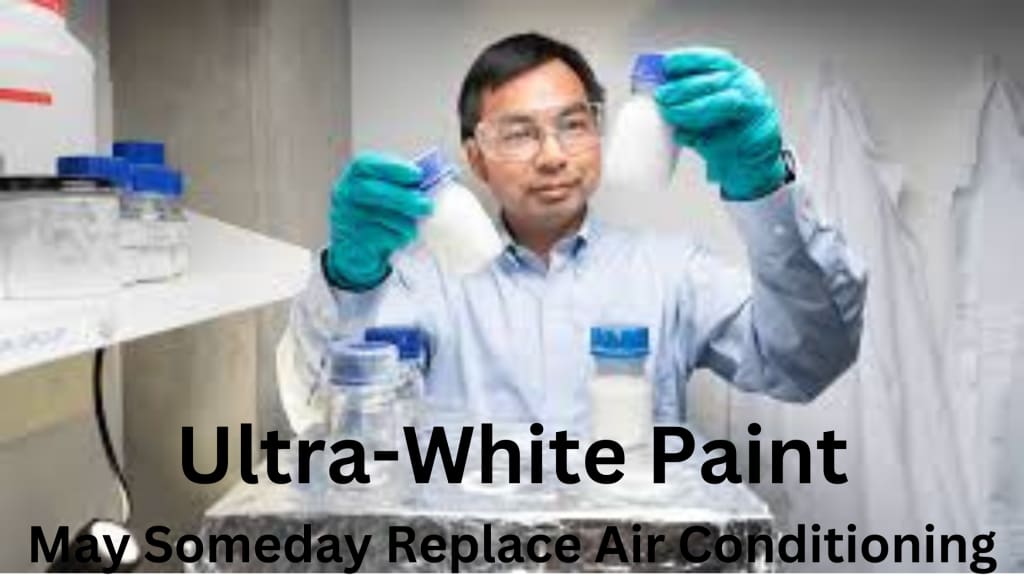Ultra-White Paint
May Someday Replace Air Conditioning

Introduction
The problem with air conditioning
The emergence of ultra-white paint
Definition and explanation
How does ultra-white paint work?
Reflecting sunlight and heat
Benefits of ultra-white paint
Energy efficiency
Cost savings
Environmental impact
Current challenges and limitations
Potential applications of ultra-white paint
Buildings and homes
Vehicles and transportation
Electronics and appliances
Future Prospects and Research
Conclusion
Ultra-White Paint May Someday Replace Air Conditioning
Air conditioning has become an indispensable part of our lives, providing relief from sweltering heat during the summer months. However, the growing concern over its environmental impact and energy consumption has led researchers to explore alternative solutions. One such promising innovation is the development of ultra-white paint, which has the potential to revolutionize cooling technologies and eventually replace air conditioning systems altogether.
Introduction
Air conditioning has transformed the way we live and work, making it possible to maintain comfortable indoor temperatures even in the hottest climates. However, the widespread use of air conditioning has led to several issues that demand our attention. The energy consumption of these systems contributes significantly to greenhouse gas emissions, exacerbating climate change. Additionally, the high costs associated with operating and maintaining air conditioning units pose a financial burden for many households and businesses. In this context, the emergence of ultra-white paint offers a promising solution to address these challenges.
The problem with air conditioning
Traditional air conditioning systems rely on energy-intensive methods to cool indoor spaces. They consume significant amounts of electricity, resulting in higher utility bills and placing a strain on the power grid. Moreover, the refrigerants used in air conditioners, such as hydrofluorocarbons (HFCs), have a detrimental impact on the environment. These chemicals contribute to the depletion of the ozone layer and also act as potent greenhouse gases, trapping heat within the atmosphere and exacerbating global warming.
The emergence of ultra-white paint
Ultra-white paint, also known as radiative cooling paint, is a technological breakthrough that aims to address the drawbacks of conventional cooling methods. This innovative paint is designed to reflect a large portion of sunlight, preventing the absorption of heat by buildings and other structures. By reflecting sunlight, ultra-white paint effectively reduces the amount of solar radiation entering the interior spaces, thereby lowering the need for air conditioning.
How does ultra-white paint work?
The adoption of ultra-white paint offers several benefits, making it a unique composition of ultra-white paint that enables it to reflect a significant amount of sunlight. Traditional paints typically absorb most of the solar radiation, leading to increased heat absorption and subsequent warming of the surface. In contrast, ultra-white paint is formulated with advanced materials that possess exceptional reflectivity in the visible and near-infrared spectra. This high reflectivity allows the paint to bounce back a substantial portion of the sunlight, keeping the surface significantly cooler.
Benefits of ultra-white paint attractive alternative to traditional cooling methods.
Energy efficiency: By reducing the amount of solar radiation absorbed by buildings, ultra-white paint can help lower indoor temperatures naturally. This results in a decreased reliance on energy-intensive air conditioning systems, leading to substantial energy savings and reduced greenhouse gas emissions.
Cost savings: The use of ultra-white paint can lead to significant cost savings for homeowners and businesses. By minimizing the need for air conditioning, electricity bills can be reduced, easing the financial burden associated with cooling indoor spaces.
Environmental impact: Ultra-white paint contributes to mitigating climate change by reducing energy consumption and lowering greenhouse gas emissions. The widespread adoption of this technology could result in a significant reduction in carbon dioxide emissions, helping to combat global warming.
Current challenges and limitations
While ultra-white paint shows great promise, there are still some challenges and limitations that need to be addressed for widespread adoption.
One of the challenges is the durability of the paint. Ultra-white paint needs to maintain its high reflectivity over time and withstand exposure to various weather conditions. Researchers are actively working to enhance the longevity and resilience of the paint to ensure its effectiveness in the long run.
Another limitation is the application of ultra-white paint on different surfaces. Currently, the paint is primarily designed for use on rooftops and exterior walls. However, expanding its applicability to other surfaces, such as windows, would further enhance its cooling capabilities and overall effectiveness.
Furthermore, the availability and affordability of ultra-white paint are crucial factors. For widespread adoption, the paint should be accessible to a wide range of consumers and affordable compared to traditional paints. Continued research and development are necessary to optimize the production processes and bring down the cost of manufacturing ultra-white paint.
Potential applications of ultra-white paint
Ultra-white paint has a wide range of potential applications across various industries and sectors.
In the building and construction industry, applying ultra-white paint on rooftops and exterior walls can significantly reduce the heat absorbed by buildings. This can lead to lower indoor temperatures, reduced energy consumption, and enhanced comfort for occupants. The use of ultra-white paint in commercial and residential buildings can result in substantial energy savings and contribute to sustainable architecture.
Beyond buildings, ultra-white paint can also be utilized in transportation. Coating vehicles, such as cars and buses, with this paint, can help reduce the heat absorbed by their surfaces, minimizing the need for air conditioning and improving fuel efficiency. This technology can have a significant impact on reducing greenhouse gas emissions from the transportation sector.
In addition, ultra-white paint can find applications in electronics and appliances. By applying the paint to the exteriors of devices, such as smartphones, laptops, and refrigerators, heat absorption can be minimized, leading to improved energy efficiency and extended lifespan of the electronics.
Future Prospects and Research
The development of ultra-white paint is still in its early stages, and ongoing research and advancements are expected to further optimize its performance and expand its applications. Scientists are exploring new materials and coatings to enhance the paint's reflectivity and durability.
Efforts are also being made to improve the colour options of ultra-white paint. While the paint is predominantly white to maximize reflectivity, researchers are working on creating variations that cater to different aesthetic preferences, allowing for more design flexibility without compromising its cooling properties.
Moreover, collaborations between researchers, paint manufacturers, and policymakers are crucial to accelerate the adoption and integration of ultra-white paint into building codes and regulations. By incentivizing the use of energy-efficient technologies like ultra-white paint, governments can encourage sustainable practices and promote the transition towards a greener future.
Conclusion
Ultra-white paint holds immense potential to revolutionize cooling technologies and reduce our reliance on air conditioning systems. With its ability to reflect sunlight and minimize heat absorption, this innovative paint offers a sustainable and energy-efficient solution for cooling indoor spaces.
While there are challenges to overcome and further research is needed, the development of ultra-white paint brings us one step closer to a future where we can enjoy comfortable temperatures while minimizing environmental impact and reducing energy consumption.
About the Creator
Riaz Sharif
I am soft-spoken person, like a "Gentle Scholar" I am trying always to enable effective interaction with others. My passion is continuous learning and personal growth, which drives me to constantly seek new knowledge and experiences.
Enjoyed the story? Support the Creator.
Subscribe for free to receive all their stories in your feed. You could also pledge your support or give them a one-off tip, letting them know you appreciate their work.






Comments
There are no comments for this story
Be the first to respond and start the conversation.